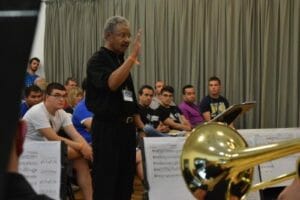Explore Pérotin’s extraordinary “Viderunt omnes,” music historians’ first documented work in four voices! We go over musical concepts useful for understanding the work — including polyphony, organa, clausulas, and plainchant — while looking at the context in which it came to be (hint: Christmas ca. 1198!).
Video Transcript
Hello everyone, and happy holidays! Today we’ll be looking at Pérotin’s “Viderunt omnes,” a very early work, and certainly one of the oldest Christmas songs (and I thought my dad’s Peter Alexander album was old!). Get ready; it’s time for a MITA Blitzlesson.
Imagine a world where we’ve never heard a Mahler symphony, a Bach cantata, or even a madrigal, a world where textures with multiple, independently-moving voices – also known as polyphony – barely exist at all. That’s where listeners were during the holiday season of 1198, when Pérotin is believed to have composed “Viderunt omnes.” It’s hard to overstate how exceptional this work was for its time.
“Viderunt omnes” is written in a style called “organum quadruplum.”We’ll get to the “organum” part later, but “quadruplum,” refers to the fact that the work has four voices, which is important because this is historians’ first documented example of a work in four voices. Let’s listen to just the beginning.
If it sounds shocking now, think about how it must’ve sounded to listeners at the time, who were only just getting used to music in two parts, or in other words, hearing intervals at all. The earliest organa used “cleaner”-sounding 4ths and 5ths, but Perotin’s range is much broader, including the use of spiky dissonances.
Though Pérotin’s harmonic complexity, documented in the Magnus liber, paved the way for the medieval counterpoint that would come later, “Viderunt omnes” often defies today’s concept of medieval counterpoint, with dissonances on downbeats and parallel fifths. Listen to this, essentially, cluster chord, which sounds more like something from a modern Eric Whitacre choir piece than a moment from a piece composed over 800 years ago.
Or how about this wild cadence?
Speaking of dissonance, Perotin – and his predecessor in the Notre Dame School, Léonin – managed dissonance using six rhythmic modes. Four of those modes were based on the number three, which in their era was associated with the holy trinity and therefore a “sacred” use of time. Pérotin’s use and occasional mixing and matching of the first, fifth, and sixth rhythmic modes, results in passages like this:
Does that remind you of any time signatures you know and love?
Another interesting feature about “Viderunt omnes” is that, for its time, it was a long work. Most of the work is in the organum style. Remember I promised we’d get back to it? In an organum, the tenor voice can mostly be described as a sustained drone, but in one section Pérotin speeds up the tenor so that it follows the rhythmic modes. Such a section is known as a “clausula.” Our clausula is short in the context of the piece. Let’s hear the whole thing:
Can you feel the absence of the held-out tenor voice? There’s even silence for a moment!
After the clausula, we’re back into the organum style, and then Pérotin closes with the heavy-hitter of the day: plainchant, which, if you aren’t familiar, was a single line sung in unison. Every liturgical composition at this time had at least some plainchant. So, the structure of “Viderunt omnes” is organum-clausula-organum-plainchant.
The plainchant section contains the majority of the words. In fact, the entire organum-clausula-organum portion, which lasts several minutes, is made up of only the first two words, “Viderunt omnes!” Those two words are sung so slowly that it’s almost impossible to understand any of the text until we get to the plainchant. But it’s still worth considering our joyful little text. “Viderunt omnes” is Latin for “All shall see.” The plainchant follows: All shall see “salvation to the end of the earth of our God. Rejoice in God all the Earth.”
A cleric at the University of Paris shortly before Pérotin’s tenure said of an organum in just two voices that the music was dangerously tempting but also “transports the soul to the company of angels.” Imagine if that cleric could have heard Pérotin’s bold and heavenly “Viderunt omnes.” He probably would have said it was a Christmas miracle.
If you liked the video, don’t forget to prove it. Talk to us in the comments, and subscribe to our channel for more MITA Blitzlesson videos. On behalf of all of us on the ArtsInteractive MITA team, happy holidays!
Learn More about “Viderunt Omnes”
Check out the totally-free MITA Sampler to hear the whole thing and dig deeper.




10 Responses
Heavenly
Thank you, Susan!
Stefan – I enjoyed your clear explanation. You’re a good teacher!
Thank you for watching, Jim!
Thank you for the informative video! I learned a lot!!
Thanks for watching, Ina!
Very informative video. Thumbs up!!
Thank you, Arthur!
Very enjoyable read! I’m learning about this in class right now, and this was very helpful. Thank you.
And it is now being used to help restore the acoustics of Notre Dame. An astonishing and totally apt reverberation of an 800-year-old masterpiece!